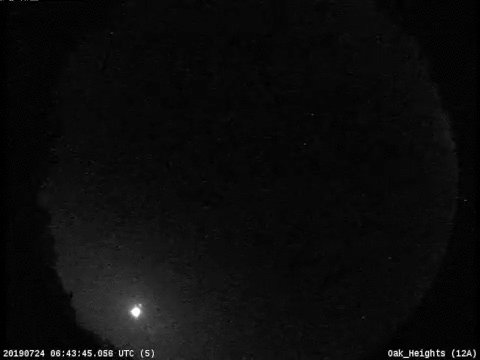In the wee hours of Wednesday morning, a fiery space rock as bright as the full moon hurled through the sky above Bancroft, Ontario, Canada.
The fireball let out several bright flares before it extinguished, dropping a number of meteorite fragments on Earth’s surface.

The Western University All-Sky Camera Network picked up the fireball at 2:44 a.m. ET (July 24) across southern Ontario and Quebec.
The fireball was about 400,000 times fainter than the sun, or about the brightness of the full moon.
From the astronomers’ analysis, they think the meteoroid that created the fireball was about the size of a small beachball, or nearly 12 inches (30 centimeters) across.
“This fireball likely dropped a small number of meteorites in the Bancroft area, specifically near the small town of Cardiff,” Peter Brown, an expert in meteors at Western University, said in a statement. “We suspect meteorites made it to the ground because the fireball ended very low in the atmosphere just to the west of Bancroft and slowed down significantly. This is a good indicator that material survived.“
The university’s camera network captured the fiery rock’s trek through the atmosphere on video, which will help researchers figure out where in the solar system it originated.
Steven Ehlert of NASA’s Meteoroid Environment Office analyzed the video, saying these fragments likely hit the ground near Bancroft, Ontario. The camera network is run jointly by Western University and this NASA office at the Marshall Space Flight Center in Huntsville, Alabama.
From their preliminary analysis, the researchers think the fireball first lit up the skies at an altitude of 58 miles (93 kilometers) just south of Oshawa over Lake Ontario, before dashing over Clarington and passing just west of Peterborough. Finally, the fireball appears to have extinguished itself just west of Bancroft, according to the university’s statement.
These meteorite fragments were in the size-range of tens to hundreds of grams when they hit the ground, the researchers said.
Brown and his colleagues are asking that anyone who may have heard anything unusual this morning or who has found a possible meteorite to contact them at Western University or the Royal Ontario Museum.
If you find a suspicious rock, here are a few tips to help you figure out if it’s a meteorite:
- Meteorites tend to be dark, with a scalloped surface.
- They are typically more dense than an average rock.
- Due to their metal content, meteorites are often attracted to magnets.
Meteorite hunters… You should quickly head to Bancroft, Ontario… And good luck!
[Western University, Live Science]











